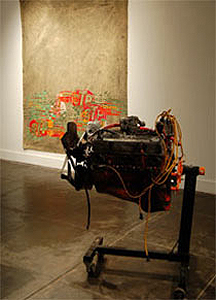Sean Duffy
at Laguna Art Museum Laguna Beach, California
Recommendation by Roberta Carasso
 Sean Duffy, 'Small Block' and 'Die Hard,' installation view
Sean Duffy, 'Small Block' and 'Die Hard,' installation view
Continuing through January 23, 2011
The content is largely autobiographical, and this in Sean Duffy's case means fun, playful, and good humored. Duffy grew up with a dad who raced his Land Cruisers in several important races. Being a together family, Duffy's mom and his three older sisters painted the cars with zebra stripes and customized each vehicle. Entering the museum, visitors are greeted by one of those Searcher Land Cruises, by now a bit worn and a bit nostalgic, but duded up with an overall black and white stripped design. Racing was a family affair and so were vintage vehicles. Duffy regards the automobile culture, particularly in the era he grew up, and all that is associated with it, as a distinct art movement. Certainly, the phenomenon of drag racing and crowded freeways have been and are very much a Southern California experience. The impression that comes to mind is a term coined by Art in America - Provisional Art, where artists work in a temporary uncrafted style.
In the show, there are several sculptures made from hefty car parts, braced together, not welded, and each mounted on a wood crate, definitely a temporary and uncrafted style. The most inventive works are Duffy's collages where he razors through layers of art magazines, bringing out colors and shapes in the most adept way, creating a three-dimensional collage. Most appealing though are his sculptures made from large red or white gas cans. Duffy assembles these with electric cords for lighting, security, and a linear effect. The black handles and black round tops, the cords and the ever-present ziptabs turn these mundane objects into glowing magical creatures. Duffy brings art and the automobile together, deconstructing art magazines and gas cans, turning them into something totally unexpected and wonderful. While the quality is inconsistent, there is much to enjoy and think about, especially the unpretentious intimacy of Duffy's thought processes and how they lead to these personal creations.
Laguna Art Museum
The content is largely autobiographical, and this in Sean Duffy's case means fun, playful, and good humored. Duffy grew up with a dad who raced his Land Cruisers in several important races. Being a together family, Duffy's mom and his three older sisters painted the cars with zebra stripes and customized each vehicle. Entering the museum, visitors are greeted by one of those Searcher Land Cruises, by now a bit worn and a bit nostalgic, but duded up with an overall black and white stripped design. Racing was a family affair and so were vintage vehicles. Duffy regards the automobile culture, particularly in the era he grew up, and all that is associated with it, as a distinct art movement. Certainly, the phenomenon of drag racing and crowded freeways have been and are very much a Southern California experience. The impression that comes to mind is a term coined by Art in America - Provisional Art, where artists work in a temporary uncrafted style.
In the show, there are several sculptures made from hefty car parts, braced together, not welded, and each mounted on a wood crate, definitely a temporary and uncrafted style. The most inventive works are Duffy's collages where he razors through layers of art magazines, bringing out colors and shapes in the most adept way, creating a three-dimensional collage. Most appealing though are his sculptures made from large red or white gas cans. Duffy assembles these with electric cords for lighting, security, and a linear effect. The black handles and black round tops, the cords and the ever-present ziptabs turn these mundane objects into glowing magical creatures. Duffy brings art and the automobile together, deconstructing art magazines and gas cans, turning them into something totally unexpected and wonderful. While the quality is inconsistent, there is much to enjoy and think about, especially the unpretentious intimacy of Duffy's thought processes and how they lead to these personal creations.

